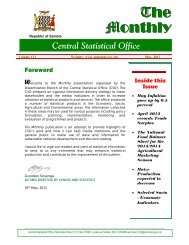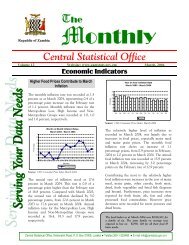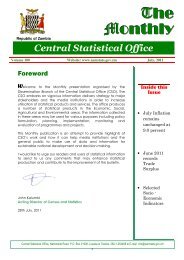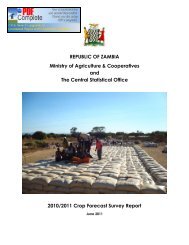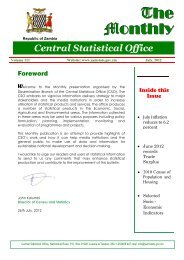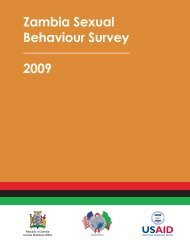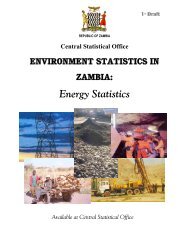Vol 16 2004 The Monthly July.pdf - Central Statistical Office of Zambia
Vol 16 2004 The Monthly July.pdf - Central Statistical Office of Zambia
Vol 16 2004 The Monthly July.pdf - Central Statistical Office of Zambia
- No tags were found...
You also want an ePaper? Increase the reach of your titles
YUMPU automatically turns print PDFs into web optimized ePapers that Google loves.
<strong>The</strong> <strong>Monthly</strong>Higher Maize Grain Prices, Fuel and TransportCosts Influence <strong>July</strong> InflationAnnual food inflation was recorded at 19.9 percentgaining 1.2 percentage points on the June rate <strong>of</strong> 18.7percent. From June to <strong>July</strong> <strong>2004</strong>, the index for foodincreased by 0.4 percent.Relatively higher prices were recorded for some fooditems, especially maize grain, other cereals, freshmeat, fish, dried Kapenta, dressed chicken, driedbeans, shelled groundnuts, milk and milk products,eggs, cooking oil, salt and other processed foodproducts. Price reductions were however registeredfor maize meal, fresh vegetables, fresh fruits, sweetpotatoes, and raw cassava tubers.Annual non-food inflation rate stood at 19.0 percent,increasing by 0.5 <strong>of</strong> a percentage point on the Junerate <strong>of</strong> 18.5 percent. Between June and <strong>July</strong> <strong>2004</strong>, theNon-Food index increased by 0.9 percent. Non-foodinflation was largely due to increases in the cost <strong>of</strong>fuel, mini bus fares, household energy (paraffin,candles), house rent, furniture and householdappliances, leisure goods (television sets, videorecorders), clothing and footwear.Maize Grain Prices RiseA comparison <strong>of</strong> prices between June and <strong>July</strong> <strong>2004</strong>,shows that the average price <strong>of</strong> Maize Grainmeasured in a 20-litre tin increased by 8.5 percent,from K9,468 in June to K10,271 in <strong>July</strong> <strong>2004</strong>. <strong>The</strong>average price per 1kg <strong>of</strong> dressed chicken increased by1.4 percent, while the price per 1kg <strong>of</strong> dried SiavongaKapenta went up by 4.2 percent. However, maizemeal prices dropped during the month. For instance,the average price per 25kg bag <strong>of</strong> Roller Mealdropped by 3.2 percent, from K25,053 in June toK24,249 in <strong>July</strong> <strong>2004</strong>.National Average Prices for selectedproductsProduct June <strong>July</strong>Percentagechange(%)<strong>Central</strong> <strong>Statistical</strong> <strong>Office</strong>International TradeExports Down in June <strong>2004</strong><strong>The</strong> total value <strong>of</strong> export earnings in June wasK564,947 million as compared to K715,736 million inMay <strong>2004</strong>. This is equivalent to 21 percent decline inthe total value <strong>of</strong> export revenue. On the otherhand, imports recorded K932,676 million in May ascompared to K936,833 million in June <strong>2004</strong>. Ingeneral, exports have shown a downward trend whileimports have increased leading to a trade deficit inJune <strong>of</strong> K 371,886 million.Total Exports, Imports & Trade Balance,January to June <strong>2004</strong>, (K’ Millions)PeriodImports Domestic Re-Exports Total Exports Trade(cif) Exports (fob) (fob) (fob) BalanceJan-04 600,902 444,799 2,<strong>16</strong>0 446,959 -153,943Feb-04 587,700 431,473 1,282 432,755 -154,945Mar-04 814,284 637,604 9,948 647,552 -<strong>16</strong>6,732Sub - Total Q1 2,002,886 1,513,876 13,390 1,527,266 -475,620Apr-04 757,199 608,389 11,906 620,295 -136,904May-04 932,676 709,643 6,093 715,736 -2<strong>16</strong>,940Jun-04* 936,833 562,006 2,941 564,947 -371,886Sub - Total Q2 2,626,708 1,880,038 20,940 1,900,978 -725,730Grand Total 4,629,594 3,393,914 34,330 3,428,244 -1,201,350Note: (*) ProvisionalSource: CSO, International Trade Statistics,<strong>2004</strong>Exports, Imports & Trade Balance, Januaryto June <strong>2004</strong>, (K’ Millions)1,200,0001,000,000800,000600,000400,000200,0000-200,000-400,000-600,000Jan-04 Feb-04 Mar-04 Apr-04 May-04 Jun-04*Imports (cif) Total Exports (fob) Trade BalanceWhite maize 20 ltr tin 9,468 10,271 8.5White breakfast 25kg 32,718 32,342 -1.1White roller 25kg 25,053 24,249 -3.2Mixed cut 1 kg 11,011 11,354 3.1Dried Beans 1 kg 3,962 4,424 11.7Shelled Groundnuts 1kg 3,788 4,415 <strong>16</strong>.6Dressed Chicken 1kg 12,789 12,972 1.4Dried kapenta Siavonga 26,422 27,537 4.2Mini bus fare Chilenje toTown1,300 1,500 15.4Petrol 1ltr 4,365 4,601 5.4Diesel 1ltr 3,800 3,981 4.8Paraffin 1ltr 2,864 2,962 3.4Page 2
<strong>The</strong> <strong>Monthly</strong>Imports by HS sections, January – June<strong>2004</strong>, K’MillionsSection DescriptionJan-04 Feb-04 Mar-04 Apr-04 May-04 Jun-04*1 Live Animals; Animal Products 1,934 1,938 2,675 3,668 4,274 3,4842 Vegetables Products 21,327 30,248 39,687 27,401 13,554 32,9953 Animal Or Vegetables Fats And Oils And <strong>The</strong>ir Cleavages 13,848 22,006 <strong>16</strong>,942 14,560 14,467 15,6964 Prepared Foodstuffs; Beverages, Spirits And Vinegar 12,428 9,481 8,070 9,053 10,059 8,1065 Mineral Products 138,187 83,599 130,808 92,752 115,386 132,73<strong>16</strong> Products Of <strong>The</strong> Chemical Or Allied Industries 88,018 96,936 83,058 66,008 90,566 124,4717 Plastics And Articles <strong>The</strong>re<strong>of</strong>;Rubber And Articles 29,594 32,529 37,895 38,273 72,097 63,4788 Raw Hides And Skins, Leather, Furskins And Articles <strong>The</strong>re<strong>of</strong>; 1,098 486 774 794 798 7179 Wood And Articles Of Wood; Wood Charcoal; Cork And Artcles 484 1,053 2,174 526 1,<strong>16</strong>7 79610 Pulp Of Wood Or Of Other Fibrous Cellulosic Material; Recovered 24,865 19,757 113,026 <strong>16</strong>0,949 170,726 133,15711 Textiles And Textile Articles 29,734 18,958 19,676 <strong>16</strong>,732 20,388 22,24512 Footwear,Headgear,Umbrellas,Sun Umbrellas 4,853 4,194 3,904 3,196 3,256 4,14313 Articles Of Stone, Plaster,Cement, Asbestos, Mica Or Si 8,707 7,090 6,387 6,234 8,249 11,46314 Natural Or Cultured Pearls, Precious Or Semi-Precious Stones 742 22 69 32 1,183 3615 Base Metals And Artcles Of Base Metal 44,234 51,621 73,648 60,863 85,135 86,609<strong>16</strong> Machinery And Mechanical Appliances; Electrical Equip 110,138 136,770 209,470 186,500 240,250 202,05617 Vehicles,Aircraft, Vessels And Associated Transport Equip 51,7<strong>16</strong> 58,238 52,400 52,172 67,419 74,37718 Optical, Photographic, Cinematographic, Measuring 11,585 5,861 7,923 4,804 7,512 12,81019 Arms And Ammunition;Parts And Parts And Accessories 64 147 52 892 53 27720 Miscellaneous Manufactured Articles 7,344 6,764 5,632 11,736 6,130 7,13521 Works Of Art,Collectors Pieces And Antiques 3 2 13 53 5 53TOTAL: 600,902 587,700 814,284 757,199 932,676 936,834HS – Harmonised SystemNote: (*) ProvisionalSource: CSO, International Trade Statistics, <strong>2004</strong><strong>The</strong> increase in June import values over May wasmainly due to significant increases in expenditure onChemical products (K90,566 million to K124,471million), Vegetable products (K13,554 million toK32,995 million), Mineral Products (K115,386million to K132,731 million) and vehicles (K67,419million to K74,377 million) among others.Exports by HS sections, January – June<strong>2004</strong>, K’MillionsSection Description Jan-04 Feb-04 Mar-04 Apr-04 May-04 Jun-04*1 Live Animals; Animal Products 971 2,124 1,625 4,899 1,975 2,5882 Vegetables Products 24,314 42,419 41,5<strong>16</strong> 37,768 52,426 33,3013 Animal Or Vegetables Fats And Oils And <strong>The</strong>ir Cleavages 441 506 394 206 376 1724 Prepared Foodstuffs; Beverages, Spirits And Vinegar 18,199 33,934 <strong>16</strong>,302 56,675 65,525 45,7495 Mineral Products 14,314 22,369 52,925 36,289 34,725 32,6596 Products Of <strong>The</strong> Chemical Or Allied Industries 3,0<strong>16</strong> 10,475 61,122 3,435 4,571 4,8847 Plastics And Articles <strong>The</strong>re<strong>of</strong>;Rubber And Articles 855 703 742 948 1,298 1,2158 Raw Hides And Skins, Leather, Furskins And Articles <strong>The</strong>re<strong>of</strong>; 979 563 1,558 965 3,144 1,6689 Wood And Articles Of Wood; Wood Charcoal; Cork And Artcles 943 1,062 2,246 2,115 1,468 1,78410 Pulp Of Wood Or Of Other Fibrous Cellulosic Material; Recovered 13,438 588 9,831 4,487 5,376 8,14211 Textiles And Textile Articles 19,001 20,567 17,664 20,324 157,565 31,22312 Footwear,Headgear,Umbrellas,Sun Umbrellas 1,046 1,464 1,439 1,397 2,609 1,79913 Articles Of Stone, Plaster,Cement, Asbestos, Mica Or Si 28 43 2 43 112 27514 Natural Or Cultured Pearls, Precious Or Semi-Precious Stones 17,527 7,701 14,869 14,760 4,479 9,28615 Base Metals And Artcles Of Base Metal 329,505284,883421,950 411,379 371,318384,928<strong>16</strong> Machinery And Mechanical Appliances; Electrical Equip 2,259 2,978 3,206 11,184 8,382 4,13817 Vehicles,Aircraft, Vessels And Associated Transport Equip 34 92 125 261 15 69218 Optical, Photographic, Cinematographic, Measuring 0 8 2 481 0 019 Arms And Ammunition;Parts And Parts And Accessories 0 0 0 0 0 020 Miscellaneous Manufactured Articles 64 190 34 12,673 361 28921 Works Of Art,Collectors Pieces And Antiques 25 85 0 5 11 154TOTAL: 446,959432,754647,552 620,294 715,736564,946<strong>The</strong> decline in revenue for exports could beattributed mainly to the drop in export valuesbetween May and June <strong>2004</strong> <strong>of</strong> Textiles (K157,565million to K31,223 million), Preparedfoods/beverages (K65,525 million to K45,749 million)and vegetable products (K52,426 million to K33,301million). <strong>The</strong> share <strong>of</strong> these products to May exportswas about 38 percent; whereas in June theyaccounted for about 20 percent.<strong>Central</strong> <strong>Statistical</strong> <strong>Office</strong><strong>Zambia</strong>’s major trading partners during the periodMay to June <strong>2004</strong>, were mainly from Africa - (SouthAfrica, Zimbabwe, Kenya, Malawi, Tanzania andCongo DR); Europe (United Kingdom, Switzerland,Netherlands, Belgium, France and Finland). <strong>The</strong>Asian trading partners include China, Japan, Taiwan,India and United Arab Emirates).Industrial ProductionConstruction in <strong>Zambia</strong> at All timeHigh!<strong>The</strong> construction industry in <strong>Zambia</strong> is currently atits highest performance since 2000. Non-MetallicMineral Production Sector as a supplier to theconstruction industry is used as a proxy formonitoring developments in the latter. Over a period<strong>of</strong> four years the industry has registered a growth <strong>of</strong>about by 25 percent.Index140120100806040200Non-Metalic Mineral ProductionIndex, <strong>Zambia</strong>, 2000-2003100106.7 108.5124.52000 2001 2002 2003YearSource: CSO Industrial Production Statistics, <strong>2004</strong>At the end <strong>of</strong> 2003 production in auxiliary industrieswas 15 percent higher than in 2002, 17 percenthigher than in 2001 and 25 percent higher than in2000. Production between January and March <strong>2004</strong>was highest except between April and June <strong>of</strong> 2003,which recorded minimal levels.Percent302520151050Percent Growth in Non Metalic MineralProduction, <strong>Zambia</strong>, 2000-200315172002-2003 2001-2003 2000-2003YearSource: CSO Industrial Production Statistics, <strong>2004</strong>25Page 3
<strong>The</strong> <strong>Monthly</strong>Establishments in the Non-Metallic MineralProduction sector are involved in the production <strong>of</strong>Cement, Lime, Concrete Blocks and Pipes, Ro<strong>of</strong> andFloor Tiles, Railway Sleepers and electric Insulators.PercentAnnualised Growth Rate (Percent), Non-MetalicMineral Production, 2000-2003<strong>16</strong>14.78141210864206.651.742000-2001 2001-2002 2002-2003Year<strong>Central</strong> <strong>Statistical</strong> <strong>Office</strong>children Living with both parents in 2002 increasedonly by 0.1 percent over that <strong>of</strong> 1996 (61.5 percent).<strong>The</strong> trend analysis <strong>of</strong> children not living with bothparents who are still alive reveals that there has beena slight decline <strong>of</strong> 0.8 percent in 2002. <strong>The</strong> Datafurther reveals that there has been a decline in theproportion <strong>of</strong> children who do not know whethertheir parents are still alive or not from 1.2 percent in1996 to 0.9 percent in 2002. Another interestingobservation is that there has been an increase in theproportion <strong>of</strong> children who live with their motherwhile the father is dead from 5.1 percent in 1996 to6.1 percent in 2002. Whereas there has been a slightdecline in the proportion <strong>of</strong> children who live withtheir father while their mother is dead from 1.2percent in 1996 to 1.1 percent in 2002.Source: CSO Industrial Production Statistics, <strong>2004</strong>A comparison <strong>of</strong> annual growth rates <strong>of</strong> the industryshows a decline <strong>of</strong> about 6.65 percent, and 1.74percent between 2001-2002, before registering thehighest growth rate <strong>of</strong> about 14.78 percent between2002-2003.<strong>The</strong> increase in production in this sector wasattributed to mechanisation and increase in demand.Since demand for products in this sector is from theconstruction industry, it follows therefore that;growth in the Non-Metallic Mineral ProductionSector is an indication <strong>of</strong> growth in Construction.Population andDemographyOnly Three-Fifths <strong>of</strong> Children Live WithBoth Parents<strong>The</strong> 2001/2002 <strong>Zambia</strong> Demographic and HealthSurvey reports that only 61.6 percent <strong>of</strong> childrenunder the age <strong>of</strong> 15 live with both parents, whileabout 38.6 percent do not live with both parents.<strong>The</strong> report also reveals that about 8.1 percent <strong>of</strong>children do not live with their parents even thoughtheir parents are still alive. <strong>The</strong> majority <strong>of</strong> childrenlive with their mother while the father is alive butliving somewhere else (11.7 percent), while only 2.9percent live with their father while the mother isalive but living somewhere else. <strong>The</strong> Patterns havenot changed much since 1996. <strong>The</strong> percentage <strong>of</strong>Percent706050403020100Children's Living Arrangements, <strong>Zambia</strong>, 1996and 2002LwBParentsLwMFAliveLwMFDeadLwFMAliveLwFMDeadNLwPBAliveNLwPFAliveNLwPMAliveNLwPBDeadDKPAlive1996 61.5 13.4 5.1 3.3 1.2 8.9 1.7 2.2 1.5 1.22002 61.6 11.7 6.1 2.9 1.1 8.1 1.9 2.9 2.9 0.9Source: <strong>Zambia</strong> Demographic and Health Survey (ZDHS), 2002Key:LwBParentsLwMFAliveLwMFDeadLwFMAliveLwFMDeadNLwPBAliveNLwPFAliveNLwPMAliveNLwPBDeadDKPAliveLiving with both parentsLiving with mother father aliveLiving with mother father deadLiving with father mother aliveLiving with father mother deadNot living with parents both aliveNot living with parents father aliveNot living with parents mother aliveNot living with parents both deadDon’t know whether parents are still aliveChildren’s living arrangements at provincial level aresimilar even though there are variations in the levelsfrom one province to another. <strong>The</strong> report shows thatthe percentage <strong>of</strong> children living with both parents ishighest in Northern province (67.6 percent). It isclosely followed by Eastern province with 65.4percent and Copperbelt province (64.3 percent).Western province has the lowest percentage <strong>of</strong>children living with both parents (50.7 percent)followed by <strong>Central</strong> and Southern provinces bothwith 58.0 percent. In all the provinces theproportions <strong>of</strong> children living with their mother whilethe father is alive but living somewhere else arehigher than those <strong>of</strong> children living with their fatherwhile the mother is alive but living somewhere else.Page 4
<strong>The</strong> <strong>Monthly</strong>Western province has the highest percentage <strong>of</strong>children living with their mother while the father isalive (20.1 percent) followed by North-Western (13.7percent) and Southern (12.5 percent).Luapula province (10.3 percent) has the highestpercentage <strong>of</strong> children not living with parents both <strong>of</strong>whom are still alive. It is closely followed by Southernprovince with 10.0 percent. Northern province hasthe lowest with 5.2 percent.Percent80.070.060.050.040.030.020.010.00.0Children's Living Arrangements by Province,<strong>Zambia</strong>, 2001/2002<strong>Central</strong> Copperbelt Eastern Luapula Lusaka Northern N-Western Southern WesternLwBParents 58.0 64.3 65.4 62.6 60.0 67.6 59.8 58.0 50.7LwMFAlive 11.7 8.8 12.2 10.6 9.9 10.7 13.7 12.5 20.1LwFMAlive 2.5 3.3 1.9 2.0 3.4 1.6 3.8 3.0 5.2NLwPBAlive 8.8 7.3 8.2 10.3 8.6 5.2 9.0 10.0 7.4NLwPBDead 3.8 3.3 2.5 1.8 3.4 3.0 1.9 3.4 2.2Source: <strong>Zambia</strong> Demographic and Health Survey (ZDHS), 2002HealthAntenatal visits increase<strong>The</strong> proportion <strong>of</strong> women attending ante-natalclinic has increased between 2000 and 2003.This has been due to the increase in the number<strong>of</strong> women attending antenatal clinics in ruralareas, from 90.3 to 94.2 percent. That <strong>of</strong> urbanareas has marginally increased from 97.7 percentto 98.2 percent.Percentage10098969492908886Pregnant women attending ante-natalcare, <strong>Zambia</strong> 2002 and 200392.695.497.798.290.3Total Urban RuralResidence94.2<strong>Central</strong> <strong>Statistical</strong> <strong>Office</strong>Among the women attending ante-natal clinics atleast once, 78.6% <strong>of</strong> urban females and 61.0% <strong>of</strong> ruralfemales were counselled for HIV/AIDS. Thisproportion in urban areas has increased by <strong>16</strong>percentage points. In rural areas, the increase hasbeen larger (20 percentage points).Percent <strong>of</strong> Women100806040200Percent <strong>of</strong> Women Attending Antenatal CareCounselled for HIV, 2000 and 2003 ZSBS63417967 67612000 ZSBS 2003 ZSBSUrban Rural TotalSource: <strong>Zambia</strong> Sexual Behaviour Survey, 2002/3Of the rural females receiving HIV counselling, only8.3% were <strong>of</strong>fered the test, while 37.1% <strong>of</strong> females inurban areas were <strong>of</strong>fered an HIV test.Among those who received HIV counselling, 17.8%<strong>of</strong> urban females and 4.1% <strong>of</strong> rural females said theywere tested for HIV. With regards to receivingresults among those counselled, <strong>16</strong>.3% <strong>of</strong> urbanfemales and 3.0% <strong>of</strong> rural females said they knewtheir test results.Percent <strong>of</strong> Women100806040200Percent <strong>of</strong> Antenatal Women Counselled for HIVwho were Offered and HIV Test, Tested for HIVand Know Test Results, 2003 ZSBS3781918<strong>16</strong>9483Offered HIV Test Tested for HIV Know Test ResultsUrban Rural TotalSource: <strong>Zambia</strong> Sexual Behaviour Survey, 2002/32000 2003Source: <strong>Zambia</strong> Sexual Behaviour Survey, 2002/3Page 5
<strong>The</strong> <strong>Monthly</strong>GeographicalInformation SystemWater Access in Petauke District<strong>The</strong> map (refer to page 9) shows the distribution <strong>of</strong>households with access to safe water with waterpoints. Although the water point data is not in thesame state at the time <strong>of</strong> the census this map can playan important role in understanding the patterndepicted. Generally the southern part <strong>of</strong> the districtshows that households have low access to safe water(19 to 35 percent). <strong>The</strong>se wards also have a highconcentration <strong>of</strong> households and open wells and nonfunctionalboreholes. Wards in the middle percentagerange <strong>of</strong> 35 to 52 percent have a relatively fairdistribution <strong>of</strong> working boreholes. On the other handthe high concentration <strong>of</strong> boreholes in the Chisanguward accounts for the high percentages <strong>of</strong> householdswith access to safe water in the ward and surroundingareas. <strong>The</strong> location <strong>of</strong> a refugee camp in this wardexplains the high density <strong>of</strong> boreholes in this area.Available at the CSO!!<strong>Central</strong> <strong>Statistical</strong> <strong>Office</strong>• Health with 51 Indicators• Environment with 4 Indicators• Education with 23 Indicators• Economy with 38 Indicators• Demography with 42 Indicators• Child Protection with 6 IndictorsSome indicators are available at the National,Provincial, District, Constituency, and Ward.Indicators are also available by Rural and Urban, andMale and Female among other desegregationcategories.Some Indicators are available for the period from1969 to 2003.<strong>The</strong> Layman andStatisticsFoster-Hood: Fostered Children are those who havea living parent or parents, but do not live with either<strong>of</strong> them. <strong>The</strong>re are looked after by other peopleincluding relatives.Orphan-hood: Orphaned children are those whohave lost one or both parents. Children who have losttheir mother are referred to as maternal orphanswhile those who have lost their father are paternalorphans. Children who have lost both parents aresometimes referred to as double orphansZamSED 1.2!<strong>The</strong> <strong>Central</strong> <strong>Statistical</strong> <strong>Office</strong> now has available thesecond CD on the <strong>Zambia</strong> Socio-economic Database(ZamSED 1.2)<strong>The</strong> new database contains a total <strong>of</strong> 244 socioeconomicindicators compiled by the CSO and other<strong>of</strong>ficial sources <strong>of</strong> national statistics such as theMinistry <strong>of</strong> Health and Ministry <strong>of</strong> Education.<strong>The</strong> new database contains seven main sectors asfollows:• Agriculture with 80 Indicators<strong>The</strong> <strong>Central</strong> <strong>Statistical</strong> <strong>Office</strong> in collaboration with theMinistry <strong>of</strong> Agriculture and Cooperatives is currentlyprocessing the 2003/4 Crop Forecasting Survey.<strong>The</strong> main objective <strong>of</strong> the survey is to obtain informationfrom farmers on the anticipated estimates <strong>of</strong> area undermajor crops, total production expected, and crop salesinformation during the season.This information is important in assessing the expectedfood security situation in the country and also in thecomputation <strong>of</strong> the National Food Balance Sheet, used todetermine whether the country has a surplus or deficit inmajor cereals and tubers.Results will be disseminated in August.Subscribe for your free electronic copy <strong>of</strong> “<strong>The</strong><strong>Monthly</strong>” online at www.zamstats.gov.zmPage 6




